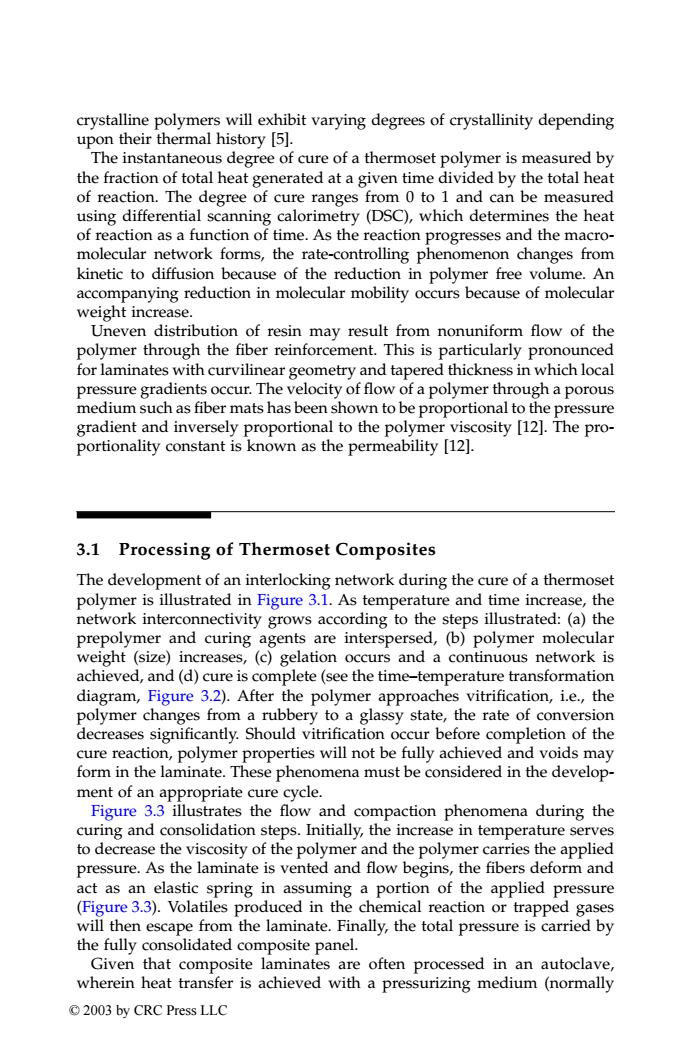正在加载图片...

crystalline polymers will exhibit varying degrees of crystallinity depending upon their thermal history [5] The instantaneous degree of cure of a thermoset polymer is measured by the fraction of total heat generated at a given time divided by the total heat of reaction.The degree of cure ranges from 0 to 1 and can be measured using differential scanning calorimetry (DSC),which determines the heat of reaction as a function of time.As the reaction progresses and the macro- molecular network forms,the rate-controlling phenomenon changes from kinetic to diffusion because of the reduction in polymer free volume.An accompanying reduction in molecular mobility occurs because of molecular weight increase. Uneven distribution of resin may result from nonuniform flow of the polymer through the fiber reinforcement.This is particularly pronounced for laminates with curvilinear geometry and tapered thickness in which local pressure gradients occur.The velocity of flow of a polymer through a porous medium such as fiber mats has been shown to be proportional to the pressure gradient and inversely proportional to the polymer viscosity [12].The pro- portionality constant is known as the permeability[12]. 3.1 Processing of Thermoset Composites The development of an interlocking network during the cure of a thermoset polymer is illustrated in Figure 3.1.As temperature and time increase,the network interconnectivity grows according to the steps illustrated:(a)the prepolymer and curing agents are interspersed,(b)polymer molecular weight (size)increases,(c)gelation occurs and a continuous network is achieved,and(d)cure is complete(see the time-temperature transformation diagram,Figure 3.2).After the polymer approaches vitrification,i.e,the polymer changes from a rubbery to a glassy state,the rate of conversion decreases significantly.Should vitrification occur before completion of the cure reaction,polymer properties will not be fully achieved and voids may form in the laminate.These phenomena must be considered in the develop- ment of an appropriate cure cycle. Figure 3.3 illustrates the flow and compaction phenomena during the curing and consolidation steps.Initially,the increase in temperature serves to decrease the viscosity of the polymer and the polymer carries the applied pressure.As the laminate is vented and flow begins,the fibers deform and act as an elastic spring in assuming a portion of the applied pressure (Figure 3.3).Volatiles produced in the chemical reaction or trapped gases will then escape from the laminate.Finally,the total pressure is carried by the fully consolidated composite panel. Given that composite laminates are often processed in an autoclave, wherein heat transfer is achieved with a pressurizing medium (normally 2003 by CRC Press LLCcrystalline polymers will exhibit varying degrees of crystallinity depending upon their thermal history [5]. The instantaneous degree of cure of a thermoset polymer is measured by the fraction of total heat generated at a given time divided by the total heat of reaction. The degree of cure ranges from 0 to 1 and can be measured using differential scanning calorimetry (DSC), which determines the heat of reaction as a function of time. As the reaction progresses and the macromolecular network forms, the rate-controlling phenomenon changes from kinetic to diffusion because of the reduction in polymer free volume. An accompanying reduction in molecular mobility occurs because of molecular weight increase. Uneven distribution of resin may result from nonuniform flow of the polymer through the fiber reinforcement. This is particularly pronounced for laminates with curvilinear geometry and tapered thickness in which local pressure gradients occur. The velocity of flow of a polymer through a porous medium such as fiber mats has been shown to be proportional to the pressure gradient and inversely proportional to the polymer viscosity [12]. The proportionality constant is known as the permeability [12]. 3.1 Processing of Thermoset Composites The development of an interlocking network during the cure of a thermoset polymer is illustrated in Figure 3.1. As temperature and time increase, the network interconnectivity grows according to the steps illustrated: (a) the prepolymer and curing agents are interspersed, (b) polymer molecular weight (size) increases, (c) gelation occurs and a continuous network is achieved, and (d) cure is complete (see the time–temperature transformation diagram, Figure 3.2). After the polymer approaches vitrification, i.e., the polymer changes from a rubbery to a glassy state, the rate of conversion decreases significantly. Should vitrification occur before completion of the cure reaction, polymer properties will not be fully achieved and voids may form in the laminate. These phenomena must be considered in the development of an appropriate cure cycle. Figure 3.3 illustrates the flow and compaction phenomena during the curing and consolidation steps. Initially, the increase in temperature serves to decrease the viscosity of the polymer and the polymer carries the applied pressure. As the laminate is vented and flow begins, the fibers deform and act as an elastic spring in assuming a portion of the applied pressure (Figure 3.3). Volatiles produced in the chemical reaction or trapped gases will then escape from the laminate. Finally, the total pressure is carried by the fully consolidated composite panel. Given that composite laminates are often processed in an autoclave, wherein heat transfer is achieved with a pressurizing medium (normally TX001_ch03_Frame Page 38 Saturday, September 21, 2002 4:51 AM © 2003 by CRC Press LLC